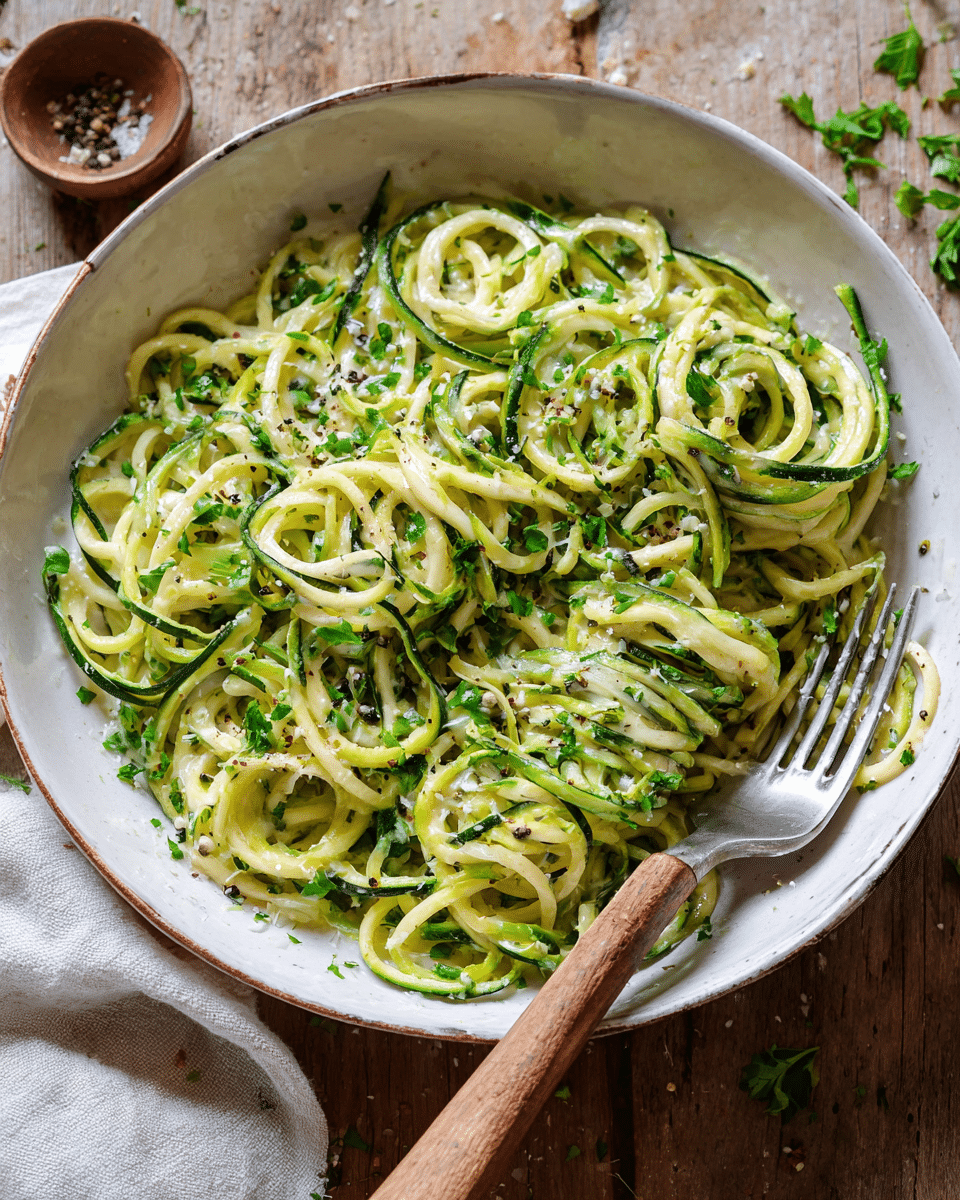Zucchini Noodle Alfredo is a wholesome, low-carb twist on the classic Italian favorite. Instead of traditional pasta, spiralized zucchini is used as a nutrient-rich substitute, offering a lighter and healthier version of fettuccine Alfredo. This dish features a creamy, garlicky Alfredo sauce made with a blend of Parmesan, cream, and butter, delivering indulgent flavor without the heaviness.
FULL RECIPE
Ingredients
- 4 medium zucchinis, spiralized into noodles
- 2 tablespoons unsalted butter
- 3 cloves garlic, minced
- 1 cup heavy cream
- ¾ cup grated Parmesan cheese
- Salt, to taste
- Black pepper, to taste
- ⅛ teaspoon ground nutmeg (optional)
- 2 tablespoons chopped fresh parsley (optional, for garnish)
Directions
- Spiralize the zucchinis and place the noodles on a paper towel. Lightly salt them and let sit for 10 minutes to draw out excess moisture. Pat dry before cooking.
- In a large skillet over medium heat, melt the butter and sauté the minced garlic for 1–2 minutes until fragrant, but not browned.
- Lower the heat slightly and pour in the heavy cream. Stir to combine and let it simmer for 3–4 minutes until slightly thickened.
- Add the Parmesan cheese, stirring constantly until fully melted and smooth. Season with salt, black pepper, and nutmeg if using.
- Add the zucchini noodles to the skillet and gently toss to coat with the sauce. Cook for 2–3 minutes until the noodles are just tender but still firm (al dente).
- Remove from heat and serve immediately, garnished with chopped parsley if desired.
Nutrition Facts
- Calories: 260
- Protein: 7g
- Total Fat: 23g
- Saturated Fat: 14g
- Cholesterol: 70mg
- Carbohydrates: 9g
- Fiber: 2g
- Sugars: 5g
- Sodium: 220mg
- Net Carbs: 7g
Health Benefits of Zucchini Noodle Alfredo
Zucchini Noodle Alfredo offers a lighter and healthier alternative to traditional pasta dishes, making it an excellent choice for those seeking low-carb or gluten-free options. Zucchini itself is rich in vitamins A and C, antioxidants, and dietary fiber, which aid digestion and support immune health. The creamy sauce, made from real dairy ingredients, provides calcium and protein, essential for bone strength and muscle repair. By replacing heavy pasta with fresh vegetables, this dish helps reduce overall calorie intake and promotes better blood sugar control, making it suitable for weight management and diabetic-friendly diets.
Choosing the Right Zucchini for Noodles
For the best texture and flavor, selecting fresh, medium-sized zucchinis is key. Smaller zucchinis tend to have firmer flesh and fewer seeds, which translates to better noodles that hold their shape during cooking. Avoid large zucchinis, as they often have a watery texture and larger seeds, which can make the noodles mushy. When spiralizing, ensure the zucchini is firm and free from blemishes. Using organic zucchinis can also reduce pesticide exposure, making your dish even healthier.
How to Spiralize Zucchini Properly
Spiralizing zucchini to create noodles requires a sharp spiralizer or a handheld tool designed for making vegetable ribbons. Start by washing the zucchini and trimming the ends. When spiralizing, apply even pressure to produce consistent, uniform noodles, which cook more evenly. To avoid sogginess, it’s recommended to lightly salt the noodles and let them sit to draw out excess moisture, then pat dry before cooking. This step is crucial to keep the dish creamy without becoming watery.
Making the Perfect Alfredo Sauce
The Alfredo sauce in this recipe balances richness with subtle seasoning to complement the delicate zucchini noodles. Using real butter, heavy cream, and freshly grated Parmesan cheese creates a creamy texture and deep flavor. Garlic adds a fragrant base, while a hint of nutmeg enhances the sauce’s complexity. The key to a smooth sauce is low and slow cooking, ensuring the cheese melts gently without curdling. Stirring constantly prevents the sauce from separating and helps achieve that velvety consistency.
Variations to Customize Your Zucchini Noodle Alfredo
This recipe lends itself well to customization. For added protein, consider incorporating grilled chicken, sautéed shrimp, or crispy bacon bits. Vegetarians might add roasted mushrooms or sun-dried tomatoes to enhance umami flavors. You can also experiment with different cheeses, such as Pecorino Romano or Asiago, for a sharper taste. For a lighter version, substitute part of the heavy cream with half-and-half or Greek yogurt. Adding fresh herbs like basil or thyme can provide an aromatic twist, while a sprinkle of crushed red pepper flakes adds a spicy kick.
Pairing Suggestions for a Complete Meal
Zucchini Noodle Alfredo pairs wonderfully with light and fresh sides to complement its richness. A crisp green salad with a tangy vinaigrette or a simple arugula and cherry tomato salad provides a refreshing contrast. For a heartier meal, roasted vegetables like asparagus, Brussels sprouts, or bell peppers make excellent accompaniments. A crusty gluten-free bread or garlic breadsticks can also round out the plate for those not avoiding carbs. When it comes to beverages, a chilled glass of Sauvignon Blanc or a crisp sparkling water with lemon can balance the creamy flavors beautifully.
Tips for Serving and Presentation
Presentation is important to elevate this dish visually and make it more appetizing. Serve the zucchini noodles piled high on a warm plate and generously spoon the Alfredo sauce over the top. Garnishing with fresh chopped parsley or basil adds a pop of color and freshness. For an extra touch, sprinkle some freshly grated Parmesan and cracked black pepper just before serving. Avoid overcooking the noodles to retain a slight crunch, which provides a pleasant texture contrast to the creamy sauce.
Storage and Reheating Advice
Because zucchini noodles release moisture, this dish is best enjoyed fresh. However, leftovers can be stored in an airtight container in the refrigerator for up to two days. When reheating, gently warm the noodles and sauce in a skillet over low heat to prevent the sauce from breaking. Avoid microwaving directly, as it can cause the noodles to become soggy and the sauce to separate. If the sauce thickens too much, adding a splash of milk or cream during reheating can help restore creaminess.
Nutritional Considerations and Dietary Adaptations
This recipe is naturally low in carbohydrates and high in fat, making it ideal for ketogenic and low-carb diets. It also suits gluten-free and grain-free lifestyles. For those who are lactose intolerant or vegan, the sauce can be adapted using plant-based alternatives such as coconut cream, vegan butter, and nutritional yeast to mimic the cheesy flavor. Reducing the amount of butter or substituting it with olive oil can make the dish slightly lighter. Adding extra vegetables or lean protein can balance the macronutrients further, catering to a variety of dietary needs.
Common Mistakes to Avoid When Making Zucchini Noodle Alfredo
One of the most common pitfalls is overcooking the zucchini noodles, which leads to mushy texture and watery sauce. To avoid this, cook the noodles just until tender and serve immediately. Another mistake is skipping the step of draining excess moisture from the noodles, which can dilute the sauce and affect its creaminess. Using pre-shredded Parmesan cheese often results in a grainy sauce because it contains anti-caking agents, so freshly grated cheese is recommended. Finally, overheating the sauce can cause it to separate, so cooking gently and stirring continuously is essential.
Conclusion
Zucchini Noodle Alfredo is a delicious, nutritious, and versatile dish that brings together the creamy indulgence of classic Alfredo sauce with the fresh, light qualities of spiralized zucchini. It caters well to various dietary preferences, from low-carb and keto to gluten-free and vegetarian. With simple techniques and a few thoughtful tweaks, this recipe can be easily customized and paired with complementary sides to create a balanced and satisfying meal. Its quick preparation and delightful flavor make it a perfect choice for weeknight dinners or special occasions alike.






